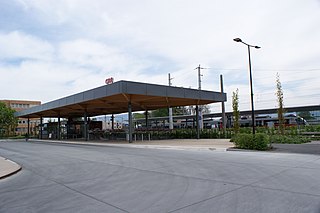
Vorarlberg is the westernmost state of Austria. It has the second-smallest geographical area after Vienna and, although it also has the second-smallest population, it is the state with the second-highest population density. It borders three countries: Germany, Switzerland, and Liechtenstein. The only Austrian state that shares a border with Vorarlberg is Tyrol, to the east.

Dornbirn is a city in the westernmost Austrian state of Vorarlberg. It is the administrative centre for the district of Dornbirn, which also includes the town of Hohenems, and the market town Lustenau.

Hohenems is a town in the Austrian state of Vorarlberg in the Dornbirn district. It lies in the middle of the Austrian part of the Rhine valley. With a population of 16,946, it is the fifth largest municipality in Vorarlberg. Hohenems' attractions include a Renaissance palace dating back to the 16th century, a Jewish history museum, and the old town center.

Bludenz is a town in the westernmost Austrian state of Vorarlberg. It is the administrative seat of the Bludenz District, which encompasses about half of the Vorarlberg's territory.

Schwarz-Weiß Bregenz or SW Bregenz is an association football club based in the town of Bregenz, Vorarlberg, Austria. The club competes in Austrian 2. Liga, the second tier of the Austrian football. Founded in 1919, it is affiliated to the Vorarlberg Football Association. The team plays its home matches at ImmoAgentur Stadion, where it has been based since 1951. The club's history includes numerous promotions and relegations and some spells of sustained success, including participation in the UEFA Intertoto Cup in 2002 and 2004. The club went bankrupt in 2005 and was subsequently refounded.

Fußballclub Dornbirn 1913, commonly known as FC Mohren Dornbirn 1913 for sponsorship reasons is a professional association football club based in the town of Dornbirn, Vorarlberg, Austria, that competes in the Austrian 2. Liga, the second tier of the Austrian football league system. Founded in 1913, it is affiliated to the Vorarlberg Football Association. The team plays its home matches at Stadion Birkenwiese, where it has been based since 2019.

Lindau-Insel station is the largest station in the city of Lindau (Bodensee) and was its most important station until passenger service resumed at Lindau-Reutin station on December 13, 2020. In the urban area there is also Lindau-Aeschach station and Lindau-Reutin freight yard. Formerly there were also Lindau-Siebertsdorf, Lindau Langenweg, Lindau Strandbad, Schoenau, Oberreitnau and Rehlings.
Hatlerdorf is the second precinct of the City of Dornbirn.

The Vorarlberg Railway denotes a through line running through the Austrian state of Vorarlberg. Its route is similar to the Rheintal/Walgau Autobahn from the border between Lindau and Hörbranz to Bludenz, where it connects to the Arlberg Railway. The entire route in Austria is owned and is operated up to Lindau-Insel by the Austrian Federal Railways.

Christian Bernhard is an Austrian politician in Vorarlberg. Bernhard is, since 6 June 2012, the Landesrat of Health and Disabled Aide of the Vorarlberg regional government.
Manfred Rein was an Austrian politician for the Austrian People's Party (ÖVP) and president of the Economic Chamber of Vorarlberg.

The Arlberg Schnellstraße (S16) is an expressway (Schnellstraße) in Austria that is part of the E 60. It runs along a length of 62.2 km between Zams and Bludenz and connects the Inn Valley Autobahn (A12) in Tyrol with the Rheintal/Walgau Autobahn (A14) in Vorarlberg. The border between the two states is located in the Arlberg Tunnel (toll), which is 13,972 m long and is also the longest road tunnel in Austria. Overall, more than half of the route runs in long tunnels.
The Vorarlberg Rhine Valley, also called the Vorarlberg Oberland and Unterland, is a section of the Alpine Rhine Valley and is divided into the Upper and Lower Rhine Valley based on the direction of flow of the river. The Unterland runs from the shore of Lake Constance to the Kummenberg, the Upper Rhine valley lies south of the Kummenberg. The Unterland covers the whole of the administrative district of Dornbirn and all the territories of the district of Bregenz that lie within the Rhine Valley. In this region, which includes the urban areas of Bregenz and Dornbirn, live about 180,000 people, around half the population of Vorarlberg. The "green lung" of this region is the Vorarlberg Ried, which is on the border with Switzerland and is surrounded by the settlements of Vorarlberg on three sides.

The Chur–Rorschach railway line, also called the Rhine Valley line, is a standard gauge railway line in Switzerland. It belongs to the Swiss Federal Railways (SBB) and is located in the cantons of St. Gallen and the Grisons.
The Rhine delta of Lake Constance is the river delta on the southeastern shore of Lake Constance, which the Rhine has formed in a former sea area. It lies mostly in the Austrian province of Vorarlberg, smaller areas are in the Swiss canton of St. Gallen. The two peninsulas in the lake are called Rheinspitz (west) and Rohrspitz (east).

Lustenau railway station is a railway station in the town of Lustenau, located in the district of Dornbirn in the Austrian state of Vorarlberg. It is an intermediate stop on the standard gauge St. Margrethen–Lauterach line of Austrian Federal Railways (ÖBB).

Bregenz Riedenburg railway station, also known as Riedenburg railway station, is a railway station in the town of Bregenz, the capital of the district of Bregenz in the Austrian state of Vorarlberg. It sits at the junction of the standard gauge Vorarlberg and St. Margrethen–Lauterach lines of Austrian Federal Railways (ÖBB).
The Eliteliga Vorarlberg is a third-tier division of Austrian football introduced in the 2019–20 season as one of the successor of the Austrian Regionalliga West. It covers the Austrian state of Vorarlberg and is one of five leagues at this level.

Lauterach railway station is a railway station in the town of Lauterach in the district of Bregenz in the Austrian state of Vorarlberg. It sits at the junction of the standard gauge Vorarlberg and St. Margrethen–Lauterach lines of Austrian Federal Railways (ÖBB).



















